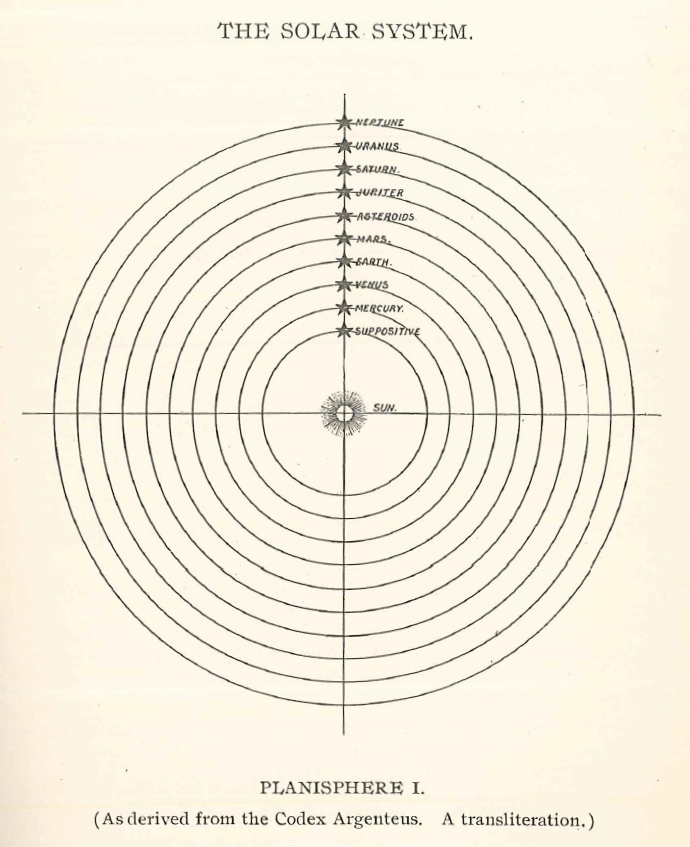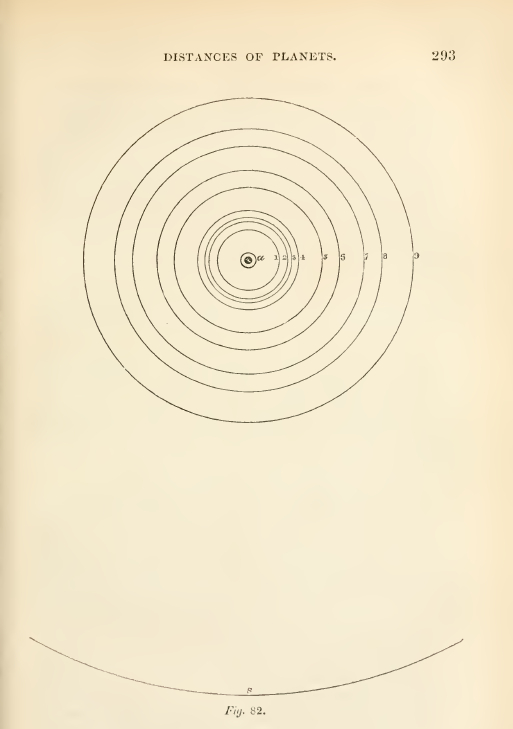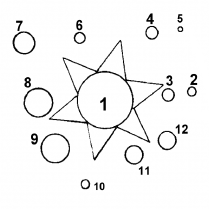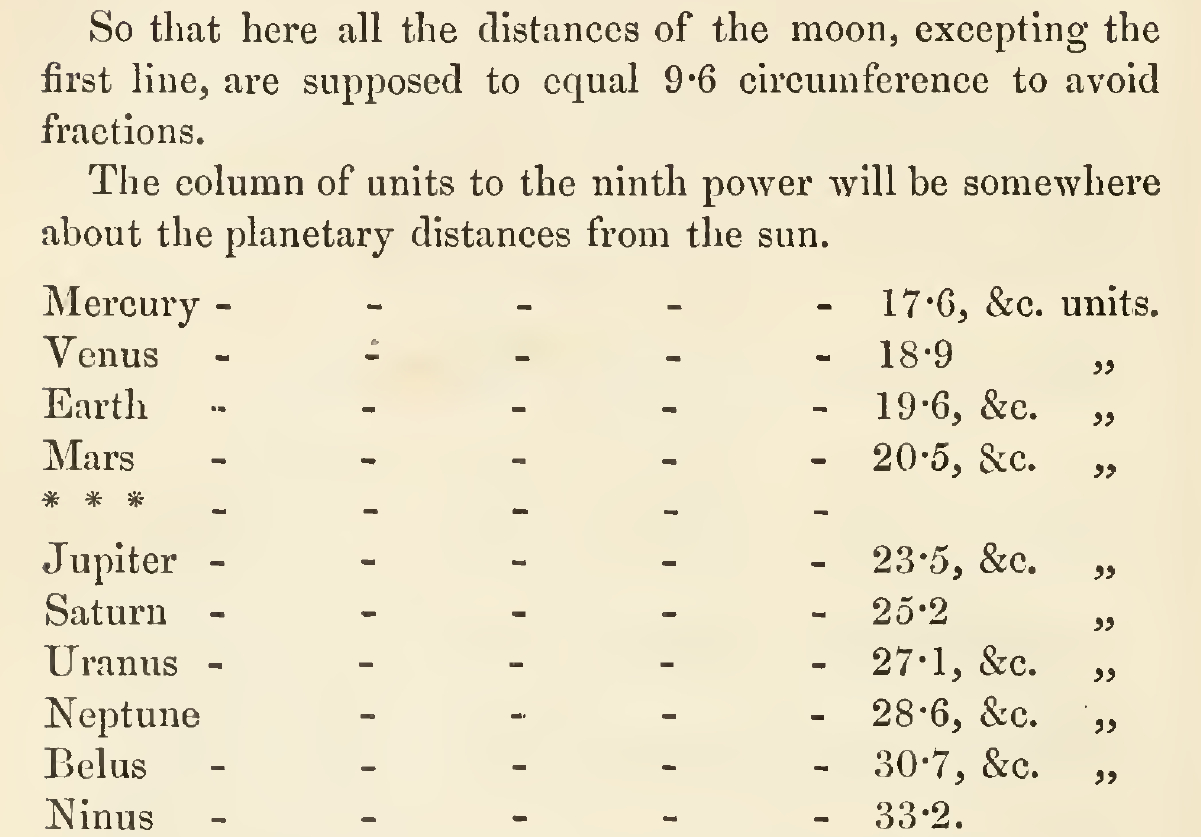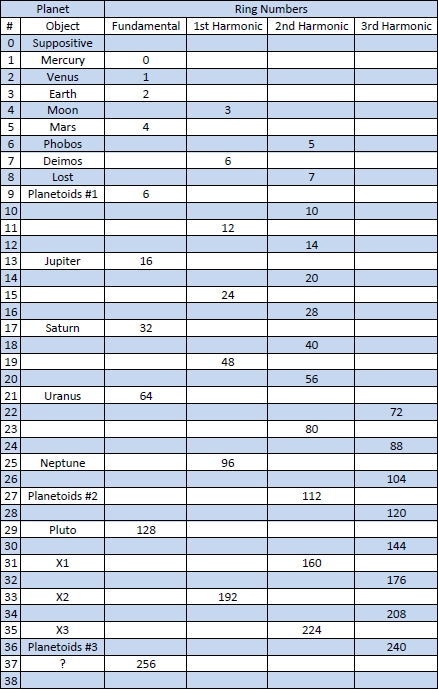The Planisphere.
"The following passage from Vol. 3,
No. 5 of "The Greater Light" will show how
accurate the results were when the Mosaic Systems for determining the distances
of the planets from the Sun was applied to verify the distance of the planet
whose orbit is beyond Neptune: — it may not be out of place to mention here
that "The Philadelphia Press"
of October 20th, 1901, gives magnificent illustrations and descriptions of
the brilliant theory advanced by Prof. George Forbes, of Anderson College,
Glasgow, in relation to the existence of an ultra-Neptunian planet. The
learned Professor, by abstruse calculation, fixes the distance of this
planet at
9,300,000,000 miles from the sun. As, therefore, the
distance of Uranus as Mosaically indicated by the Law just deducted is
1,859,544,000 miles from the sun, so, by this same
law,
1,859,544,000 x 5 = 9,297,720,000 miles, thereby
corresponding with the approximate distance of the Forbe's planet from the
sun, which, consequently, by the Mosaic law, is the third beyond Uranus.
From this stand-point
another planet
is demanded between Neptune and that of Forbes, at a distance of
4,648,860,000*
miles from the sun."
THE PLANETS
In further consideration of aggregate matter, by the Mosaic System the Sun has been displaced 4110 miles from the centre of the Solar System; possibly due to the disruption and vaporization of the Asteroid Planet.
"In further investigation, where did planet Suppositive go? And just what symbol does it have?"
|
Planet I Astronomy.—With regard to Vulcan, the following deductions appear not to have been noticed: 1. Leverrier's orbits were said by himself only to be possible if the inclination of Vulcan was large—say 12° or over; 2. Watson's observation fits one of Leverrier's orbits, as shown by Gaillot, but necessitates a small inclination—say 6° or thereabouts; 3. If, then, Watson's eclipse Vulcan and Leverrier's transit Vulcan are one and the same, this new planet must be on the face of the sun several times a year; but it has never been seen on the thousands of photographs, drawings, etc. Harper's New Monthly Magazine Vol. LVIII , December, 1878 Latch elucidated its position from the Codex Argenteus in 1900. Has Suppositive imploded? Or, was it blasted away from one of the Sun's former MicroNova events?
|
|
PLANET 2 Mercury 38,000,000 Miles Mosaic  |
|
PLANET 3 Venus 68,000,000 Miles Mosaic  |
|
PLANET 4 Earth 92,000,000 Miles Mosaic  |
|
PLANET 5 Mars 152,000,000 Miles Mosaic  |
|
PLANET 6 Asteroid 298,000,000 Miles Mosaic  War in Heaven 31,754 B.C. The collision of two planets, Jupiter and Asteroid; this destructive war in heaven between the Archangel Michael and Satan in the beginning of the Euphratic age; the war being the passing of a red comet; electrically connecting to Mars. "The circumferential value of one special body unduly pressed may lead to its collision with another special body, and, in turn, to a more general collision as in the case of the Galaxy, and the Jupiter Asteroid catastrophes (see The Galaxy Diagram – Planisphere III)."  |
|
PLANET 7 Jupiter 416,000,000 Miles Mosaic  |
|
PLANET 8 Saturn 894,000,000 Miles Mosaic  |
|
PLANET 9 Uranus 1,796,600,000 Miles Mosaic  |
|
PLANET X Neptune 2,724,800,000 Miles Mosaic  |
|
PLANET XI Pluto Our eleventh planet.  ~3,678,559,699 Miles Modern Avg. Pluto lies at 2,771,400,000 Miles - 4,585,719,398 Miles (Average Range 3,678,559,699 Miles). On February 18, 1930, Tombaugh discovered the tiny, distant planet by use of a new astronomic technique of photographic plates combined with a blink microscope. But, is Pluto moving? Yes, is correct, and it could of been the original Belus of antiquity."Pluto's 248-year-long elliptical orbit can take it as far as 49.3 astronomical units (AU) from the sun. (One AU is the mean distance between Earth and the sun: about 93 million miles or 150 million kilometers.) From 1979 to 1999, Pluto was actually closer to the sun than Neptune, and in 1989, Pluto came to within 29.8 AU of the sun, providing rare opportunities to study this small, cold, distant world." Read more
|
|
PLANET XII Belus Our twelth planet.  ~4,648,860,000 Miles Mosaic Desribed as the "Tenth Planet" in the Popular Science at 4.7 Billion Miles. Only 51,140,000 mile difference. "From this stand-point another planet is demanded between Neptune and that of Forbes, at a distance of 4,648,860,000* miles from the sun." 
"The distance of Uranus exceeds
the sum of the distances *Ref: The Lost Solar System of the Ancients Discovered Volume II - John Wilson 1856 Tower of Belus. "Rich, along with Rennell and Porter, concurs in the opinion that the temple of Belus was built upon the site of the tower of Babel, but is at variance as to which of the two ruins, the Mujelibe or Birs Nimroud, is best entitled to the distinction: Rennell decides in favour of the Mujelibe, Rich and Porter incline to the Birs." |
|
PLANET XIII
The one everyone is searching for as Planet 9, is actually Planet 13. But just like elevators are missing the 13th floor, so are we missing Forbes or Ninus or Nemesis, or Planet 13...
|
|
The Binary Problem... The 50 billion mile published editorial piece is for now our Binary Companion, unless the real binary is at the 9.7 billion mile marker and called Forbes/Ninus/Nemesis, the "culprit of chaos". I am interested in the 4.7 printed number, as this matches the Mosaic postion as elucidatred from the Codex Argenteus by Latch. If you follow the math of Dr. Thomas below, it may seem we may even have more planets still.... So, where is the true binary? At 50 billion miles? On what "ring" as Chan descibes? #224? "Further, it is known from the perturbations in Pluto's orbit that there is more than one planet outside Pluto; our table tells us that there should be three planets on rings #160, #192, and #224." Chan Thomas What do they preturb again? did he say Pluto pertubed by two or more planets? Yes, he did, and Latch just elucidated the mosaic distance to them, "them" being known as "Planet XII", and "Planet XIII". Or does this still need more interpretation? I think it demands it, as I am still not postive it is all correct just yet.
Ref:
The Lost Solar System of the Ancients Discovered Volume II - John Wilson
1856 |
The Thomas Chart
The Bode-Titius relationship may give us a key to the answer. Titius and Bode, two German astronomers, discovered this relationship in the eighteenth century. If we take ring numbers, or orbit numbers, of the planets through Saturn (0, 1 , 2, 4, 8, 16, 32), multiply each number by 3, add 4, divide by 10, the series becomes (0.4, 0.7, 1.0, 1.6, 2.8, 5.2, and 10.0). These numbers represent the relative distances of the then known planets from the Sun - Mercury, Venus, Earth, Mars Jupiter, and Saturn - with 2.8 representing a void with no known planet at that distance.
When the planet Uranus was discovered in 1781, it fit right into the series at
19.6; the "law" seemed strengthened, and an intense search was started for
anything that might be at the 2.8 distance. In 1801 the little planetoid Ceres
was found at 2.8; by 1945 more than 1,500 more were found on the same orbit. It
has been well established as the ring of minor planets, or planetoids, or
asteroids. In 1846 Neptune was discovered - and it seemed to disobey the rules
set down by Bode and Titius. It should have been at 38.8 on the relative
distance scale - but it was closer to 29.2. In 1930 Pluto was discovered, and
Bode-Titius seemed to fall apart, for Pluto was found close to 38.8, where
Neptune was supposed to be, whereas the Bode-Titius "law" seemed to indicate
that Pluto should be at 77.2. Since then the relationship, commonly known as
"Bode's Law", has been regarded in astronomy as nothing more than an
insignificant curiosity.
Perhaps a new look at Bode's law is in order. If so much of it is correct, then
perhaps the part which appears to be erroneous seems to be so only because of
our lack of understanding of the basics involved. First, instead of using
relative distances, we shall work with ring numbers, or orbit numbers. The first
progression (0, 1, 2, 4, 8, 16, 32, etc.) represents these numbers. Also,
instead of this progression - which is geometric except for the zero - let's
fill in all of the numbers, making a true arithmetic progression. The
numbers will be 0, 1, 2, 3, 4, 5, 6, 7, 8, and so on to 256.
Now in this progression the ring numbers 0, 1, 2, 4, 8, 16, 32, 64, 128 and 256
can be regarded as fundamental rings. All other rings can be regarded as
harmonic rings. Between any two fundamentals, the ring which lies halfway
between is the first harmonic; any ring which lies halfway between a
fundamentals and a first harmonic is a second harmonic; any ring halfway
between a second harmonic and a first harmonic, or a second harmonic and a
fundamental, is a third harmonic, and so on.
The next step is to label the ring numbers with the planets
as they actually
are positioned in the Solar system. We can simplify the table if we take
all of the ring numbers up to 8, then only the fundamentals, 1st, 2nd, and 3rd
harmonics to ring #256. The first thing we notice is that all of the planets are
on fundamentals except for Neptune. Its the only one of the planets which is on
a harmonic ring, as it appears on the first harmonic between Uranus and Pluto,
which are on fundamentals 64 and 128 respectively.
Now we come to another discovery. The number of rings between planets increases
the farther away from the Sun the planets are, until it appears that the maximum
number of rings possible between planets is 31. On each 32nd ring there has to
be a planet whether that ring is a fundamental or harmonic. That's why Neptune
is on a harmonic, the 32nd ring after Uranus, with Pluto on the 32nd ring after
Neptune.
Something else appears apparent also: When the Solar system was born, planets
tried to be born on each ring. Full-blown planets were born on every
fundamental, and on any harmonic ring 31 rings away from any other planet. On all
other rings, minor planets were born, or a ring of planetoids. Since there are
four major planets inside the planetoids on ring #8, let's assume that the
entire system is made up of three groups of four major planets plus a ring of
planetoids in each group. This means that there may be two more undiscovered
planetiod rings, #112 and #240. If we look at the minor planet rings on either
side of Jupiter, and apply Kepler's laws to them, we find that the moons of
Jupiter - even the retrograde ones - are explained as captured minor planets
from both inside and outside rings around Jupiter.
Before we examine the result of our construction, let's look into the outer
unknown regions of the Solar system: Ring #256 is where the comets turn around
and head back into the heart of the system. Further, it is known from the
perturbations in Pluto's orbit that there is more than one planet outside Pluto;
our table tells us that there should be three planets on rings #160, #192, and
#224. The total number of rings tells us that there is a fantastic number of
captured and uncaptured minor planets yet to be discovered. The junk of the
Solar system - the first orderly interpretation of Bode's Law.
How does adding "Planet Suppositive" change the chart?
It's apparent that our present moon was created on ring
#3, Phobos and #5, and Deimos on #6. Ring #7 is vacant. That presents a real
challenge. Whatever happened to the minor planet from Ring #7? The closeness of
Phobos and Deimos to Mars tells us that the rings #4, #5, and #6 closed together
a tremendous amount, most probably through a succession of events in the Solar
system causing the series of cataclysms on the Earth. It is logical that the
ring #7 also would have closed towards Mar's ring so that Mars would have
captured the minor planet from ring #7 as well as Phobos and Deimos. Once
orbiting around Mars by the Earth and be the moon-satellite so well
described on
the Idol and Calendar Gate of Tiahuanaco.
The multitudes of legends springing from the cataclysm of ~14,000 years ago about
"Venus moving into orbit" or
"Venus changing her
orbit" most probably describe the capture of our present
moon from ring #3 - which in its day, eons ago, evidently was a pretty fair
planet orbiting around the Sun. In any case, the now vacant ring #7, the records
from Tiahuanaco of a retro-grade-orbiting moon, the plethora of impact craters
on the moon and Mars, and the mountains of dense material buried in the mantle
of the Earth as uncovered by perturbed orbits in our man-made satellites, and
Bode's Law, expanded to include harmonics, now offer an orderly meaning to us.
Instabilities in the Solar System which lead to capture of minor planets may seem impossible or improbable; however, if we consider one minor instability in the Solar System, in the Earth's rotation, we can believe that major changes in stability are possible. You can find it in the Encyclopedia Britannica: mention is made of two astronomically abrupt changes in the Earth's rotation within the last hundred years. This planet of ours, is not an inertia body - it's a complex motor-generator system, as is the Solar system, the Milky Way galaxy, its parent supergalaxy, and the Universe in which we live. Astronomers of Tiahuanaco recorded stability changes on the Gate and Idol. Dr. Chan Thomas 1964
"Planet #7 may be the missing Planet Suppositive Thomas was looking for." Paul aka Nemesis8
//∞\\



